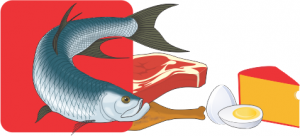Fish, chicken, lean meat or eggs can be eaten daily
These foods are good sources of important nutrients as they contain protein and also have micronutrients like iron and zinc. Fish with fatty flesh, like pilchards and sardines, have essential fatty acids, which are needed for different body functions.
It is good to eat these foods several times during the week, but they are not needed with every meal. Some of these foods have a lot of fat, and in most cases this is saturated fat.
Eating saturated fat increases a person’s risk of developing higher blood fat levels and heart disease or stroke. This fat is found just under the skin of the chicken of meat. It is best to remove the skin from chicken and trim the fat from or on the outside the meat, and throw this away.
Some of these foods are high in fat. Foods where the fat cannot be removed, such as boerewors and polony, should not be eaten often or in large amounts.
Important to note: Although cheese is made from milk and is also classified as a dairy product, it sorts under the meat group and not under the dairy group (milk, maas and yoghurt). Cheese is high in protein and contains almost no carbohydrates and can replace meat, chicken, fish or eggs in the diet. Two slices of cheese (40 g) is regarded as one serving.
Guidelines for including fish, chicken, lean meat or eggs in your diet
- These foods can be expensive and therefore money should be spent on these foods only when foods from the other groups have been included.
- A portion size for a meal does not have to be bigger than the size of the palm of your hand.
- Extra fat should be trimmed from chicken and meat, as this type of fat is harmful to health.
Examples are
- A boiled egg for breakfast or in the lunch box keeps you fuller for longer
- Cheese can be included in a sandwich for lunch time
- Chicken or meat and vegetable stew could be prepared for the evening meal.
Fish, chicken, lean meat or eggs can be eaten daily
These foods are good sources of important nutrients as they contain protein and also have micronutrients like iron and zinc. Fish with fatty flesh, like pilchards and sardines, have essential fatty acids, which are needed for different body functions.
It is good to eat these foods several times during the week, but they are not needed with every meal. Some of these foods have a lot of fat, and in most cases this is saturated fat.
Eating saturated fat increases a person’s risk of developing higher blood fat levels and heart disease or stroke. This fat is found just under the skin of the chicken of meat. It is best to remove the skin from chicken and trim the fat from or on the outside the meat, and throw this away.
Some of these foods are high in fat. Foods where the fat cannot be removed, such as boerewors and polony, should not be eaten often or in large amounts.
Important to note: Although cheese is made from milk and is also classified as a dairy product, it sorts under the meat group and not under the dairy group (milk, maas and yoghurt). Cheese is high in protein and contains almost no carbohydrates and can replace meat, chicken, fish or eggs in the diet. Two slices of cheese (40 g) is regarded as one serving.
Guidelines for including fish, chicken, lean meat or eggs in your diet
- These foods can be expensive and therefore money should be spent on these foods only when foods from the other groups have been included.
- A portion size for a meal does not have to be bigger than the size of the palm of your hand.
- Extra fat should be trimmed from chicken and meat, as this type of fat is harmful to health.
Examples are
- A boiled egg for breakfast or in the lunch box keeps you fuller for longer
- Cheese can be included in a sandwich for lunch time
- Chicken or meat and vegetable stew could be prepared for the evening meal.



